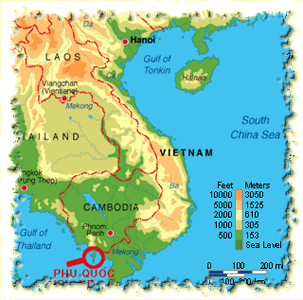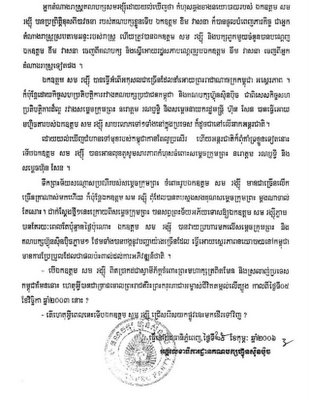 Hun Sen, the "talented circus performer" of Cambodian Politics, will go to great length to maintain himself in power, at any cost.
Hun Sen, the "talented circus performer" of Cambodian Politics, will go to great length to maintain himself in power, at any cost.
Seeing through Hun Sen
The Standard - China (Hong Kong) Business newspaper
The wily Cambodian prime minister has long held power by playing a cruel but effective psychological game with his opponents. Unsurprisingly, few are convinced that his latest gesture of reconciliation toward them is genuine, writes Vaudine England
Saturday, February 25, 2006
The wily Cambodian prime minister has long held power by playing a cruel but effective psychological game with his opponents. Unsurprisingly, few are convinced that his latest gesture of reconciliation toward them is genuine, writes Vaudine England Almost overnight, Cambodia changed from a country where most of its opposition voices were in jail or exile to one where Prime Minister Hun Sen was loudly announcing an outbreak of peace.
Earlier this month he spoke at length of the "71-hour" outburst of "national reconciliation" in which "Cambodian talked to Cambodian" and solved the country's problems. Just like that.
By February 10, the seal on the apparent outbreak of peace and kindness was set by the return to Cambodia of opposition party leader Sam Rainsy.
He had been in self-imposed exile for a year but, in carefully arranged phone calls and letters, he had apologized to Hun Sen and promised a new non- confrontational attitude, getting a royal pardon in return.
A few thousand ecstatic supporters greeted his return, as they had greeted the releases from jail of his colleague Cheah Channy, radio journalist Mam Sonando, union leader Rong Chhun, and human rights advocates Kem Sokha and Pa Nguon Tieng. United States assistant secretary of state Christopher Hill had visited Cambodia in mid- January and requested the releases, adding his voice to a chorus of complaint at the crackdown.
It was another "miracle on the Mekong," in the wry words of a Cambodian diplomat.
In Cambodian geo-politics, the phrase
"miracle on the Mekong" deliberately recalls in satirical tone the judgment of US Congressman Stephen Solarz on the July 26, 1998 elections. Despite massive intimidation, human rights abuses and perversion of the democratic process, Solarz judged the elections then as free and fair because more than 90 percent of the electorate still dared to vote.
Later forced to temper his claim of a miracle, Solarz pointed out that most people had voted against premier Hun Sen, but a split of the opposition between Prince Norodom Ranariddh's Funcinpec Party and the Sam Rainsy Party deprived them of victory.
Critics of Hun Sen, his Cambodian People's Party (CPP) and of Solarz, argued that far from being a miracle, talk of a free vote was a travesty.
"What took place in Cambodia on July 26 [1998] may not have been, as I had originally hoped, a 'miracle on the Mekong,' leading to a new birth of democracy and reconciliation in that troubled land. But it would be unfair to the millions of Cambodians who had the courage to vote to dismiss it as a totally illegitimate electoral charade," Solarz wrote in September 1998.
Observers are faced with much the same dilemma now.
It seems good news that the clutch of opposition figures and human rights activists are now out of jail. It is also reassuring when a country's leader says he "needs opposition voices" and wants Cambodians to unite to solve their problems.
But the miracle is most probably a mirage, agree diplomats, analysts and even participants in the latest Cambodian drama.
Look at the pattern provided by history, advises Pa Nguon Tieng, a director of the Cambodian Center for Human Rights and of the Voice of Democracy radio station.
The key to it all is that Hun Sen always comes out on top. He does by first repressing then appearing to offer a hand of friendship to whomever his opponents are at the time. It's a twisted act of conflict resolution: The conflict is created by the person who then offers the resolution.
"I think Hun Sen has had a lot of experience [playing persecutor-rescuer]. He understands what will benefit him in terms of conflict resolution," Pa Nguon Tieng says.
"Look at 1993 - he faced lots of problems when he was in power in a coalition with the Royalists, leading to the bloody coup of 1997. Since then, all power has been concentrated in his hands alone.
"But he had lots of international problems, even from within Asean [the Association of Southeast Asian Nations] and the people here were in strife, very poor and crying out for food.
"So he came up a plan to bring all sides of politics back to the country to participate in the 1998 elections. The international community accepted it and new aid flowed in to hold the election, helping legitimate his rule.
"Most recently the government took violent action against the human rights community, put us in jail and again drew negative reaction. So once more he had to reopen dialogue," recounts Pa Nguon Tieng.
He seems a gentle, hopeful man, and takes all this as a sign that Hun Sen is learning something. He is prepared to wait and see if Hun Sen's current outburst of reconciliation will last or prove to be just another trick.
"I hope he has learned and that the arrests shouldn't happen again," he says. But few others are are prepared to give Hun Sen the benefit of the doubt.
A Western diplomat says: "Hun Sen is manipulating everybody, so everybody is beholden to him. He is positioning himself and others to play them all off against each other."
Precisely how the current drama began and is played out reveals key themes in Cambodian political life, from sensitivity over its weakness relative to its powerful neighbors of Vietnam and Thailand, to the dominant role of Western support for democracy in the impoverished country.
Back in 1993, the United Nations administration in Cambodia - which was supposed to disarm all factions, from the murderous Khmer Rouge to the Vietnamese-backed Hun Sen regime - made do with pronouncing a free election. It then stood by while the election victor, Prince Ranariddh and his Funcinpec Party, went into coalition with Hun Sen who then proceeded to abrogate power. Murder, intimidation, secession threats and more marked the body politic.
"Cambodians had seen [former King] Sihanouk and [his son] Ranariddh bow to the election losers, share power with them, and adopt avidly their undemocratic and corrupt ways," wrote long-term observer Henry Kamm in his 1998 book Cambodia, Report from a Stricken Land.
With the elite proving such a disappointment, Kamm reckons the most lasting contribution of the UN presence in Cambodia was the handful of private human rights organizations it left behind. These groups are now performing the role that opposition parties should be playing - educating people about rights and advocating peaceful change - while the personalities and parties of Cambodia's mainstream politics remain mired in conflict.
By the mid 1990s, Funcinpec's respected finance minister Sam Rainsy had quit the ruling coalition after being stripped of his post for outspoken criticism of corruption at all levels of government. He now leads the Sam Rainsy Party, which remains in some disarray following his year-long absence. Competition meanwhile had begun between Ranariddh and Hun Sen in seducing aging leaders of the Khmer Rouge to their side. Splits, be they real or created, among the old guard of the Khmer Rouge led to the "arrest" of Pol Pot by his brutal colleague, the one-legged Ta Mok. The legendary Brother Number One, Pol Pot, was dead by April 1998.
This was national stability achieved at last, according to the Hun Sen lexicon.
Last year, Hun Sen again invoked the issue of national stability when he sought to clarify the country's border with Vietnam, once and for all. The deal signed in October between Hun Sen and the government which first put him in power sparked off the latest round of trouble however.
The apparently visceral hatred of Vietnam among some Cambodians is often used by politicians to whip up passions, and the border deal provoked public outrage, dramatic media coverage and rising tension. This gave Hun Sen the opportunity to arrest activists and journalists: Mam Sonando of Beehive Radio was accused of provoking conflict with neighboring countries, and rhetoric on a banner at rallies in December - that Hun Sen had "sold" land to Vietnam, that he was a "second Pol Pot" and had "blood on his hands" - was pretext for scooping up popular rights advocate Kem Sokha.
The border law has since been passed, and signed into effect by King Sihamoni (Sihanouk's successor in the palace).
"That's why Hun Sen could release Kem Sokha and the others," judges Pen Samitthy, editor of the biggest circulation newspaper in Cambodia, the Rasmei Kampuchea Daily.
Aware of Rainsy's urgent need to return to Cambodia to rescue his political career, Hun Sen was similarly able to reach out to him in exile in Paris.
"I need him to come back. I need opposition views because sometimes my officials lie to me. I do not want to go ahead alone. If I go alone it is like being on a horse without holding the reins," said Hun Sen on February 6.
Out of jail and now back in the offices of his Beehive Radio, Sonando remains unimpressed.
"Hun Sen is clever. When he is in deadlock, with nowhere to go, he solves problems like this to maintain power," he says. "He is like a talented circus performer."
The political procedure, Sonando explains, is similar to being robbed of something and then having to feel grateful after being allowed to buy it back.
"It's not only me. Everyone in Cambodia has to pay bribes and say thank you for things which should be ours free, as a right."
He is grateful, however, to be out of jail and thanks Hun Sen for "taking the route of Cambodian talking to Cambodian" in arranging the return of Rainsy. "Compromise is better than confrontation, so I think we can solve problems step by step," Sonando says.
Crucially, a key event on March 30, 1997, which all independent observers agree was initiated by Hun Sen, has now become a non-issue in the latest reconciliation. On that day, Rainsy and about 200 followers were holding a peaceful demonstration in front of the National Assembly to demand an independent judiciary. Four grenades were lobbed into the crowd, killing at least 15 people and wounding more than 100. The culprits escaped thanks to intervention by CPP troops.
Rainsy blamed Hun Sen for the attack, and Hun Sen blamed Rainsy for trying to discredit the ruling party. Through all the ups and downs, the increasing militarization of politics since March 1997, the 2003 elections and more, that accusation has been sacrosanct for the opposition.
Yet in Rainsy's apology prior to his pardon which allowed him to return safely to Cambodia this month, he specifically retracts his accusation that Hun Sen was responsible for the grenade attack.
This turnaround alone may fatally damage his standing as an opposition leader and all eyes are now on Rainsy and his party.
"I think Sam Rainsy has lost credibility already, not just because of the latest compromise but because of his changing behavior. But he may restore his credibility through his actions should he tell the truth about what the government does," judges Pa Nguon Tieng.
He says his colleague at the Cambodian Center for Human Rights, Kem Sokha, is a different man to Rainsy, and not a competitor for Rainsy's position as the only figure capable of standing up to Hun Sen.
"We are happy to work in civil society rather in a political party. We are just trying to spread information and the spiritual power of human rights and democracy," says Pa Nguon Tieng.
Kem Sokha, in person, is somewhat less modest.
He couldn't resist the classic politician's line - "if my people need me" - suggesting that if there was a strong call for him to wrest opposition reins from an enfeebled Rainsy's hands, then he would take on the mantle of history to do so.
At least Kem Sokha managed to avoid apologizing to Hun Sen. Indeed, he claims that his own and the other releases, and even the return of Rainsy, were all thanks to his intercessions with Hun Sen who, he says, called him several times a day in prison.
"I told him, if you want to rule the country longer you must support civil society. He will not change easily but I tried to change his mind," Kem Sokha says.
A politician before he turned to the human rights movement, Kem Sokha now claims he has two million supporters across the country and that Hun Sen has recognized his clout. Analysts agree that Kem Sokha remains a strong possible successor to Rainsy as opposition icon.
The upshot of it all is that Ranariddh's Funcinpec, the official ally of Hun Sen in government, now fears it may not be needed any more (or be allowed access to the perks and benefits of rule) if Hun Sen brings Rainsy on side. A hint of this tension was evident even before Rainsy landed at Pochentong Airport when Funcinpec Radio aired a commentary which described Rainsy as a habitual liar who had left his party members feeling hopeless.
"It's the same old fighters fighting the same old battles. . It's a matter of destabilizing the opposition, keeping them off balance, so that Hun Sen can reintroduce the facade of democracy when it suits him," a Phnom Penh- based diplomat said.
An important bone of contention remains however - the criminal defamation law that allows the courts to bring suits against opposition figures whenever it chooses (or is told to do so).
The law is an unfortunate legacy of the UN's tenure in Cambodia. It was first instituted to dampen abuse between political parties ahead of the 1993 election but has since become a tool of repression in Hun Sen's hands.
"We are trying to change the law because it is being used to silence critics; it is a very bad law that severely limits freedom of expression," Ou Virak, general secretary of the Alliance for Freedom of Expression in Cambodia told the Phnom Penh Post.
He hopes the law will be a major topic at the forthcoming Consultative Group meeting of donors this week.
Yash Ghai, a former Hong Kong University law professor who is now the UN Special Representative to Cambodia on Human Rights, agrees the law must go: "The combination of a rather loosely drafted law and the relative lack of independence and competence of the judiciary means that such laws can be used to harass political opponents and suppress freedom of expression."
Perhaps more revealing of the abiding concerns of ordinary Cambodians is the fact that circulation of the leading Rasmei Kampuchea Daily goes up when its front page stories are not about elite politics, but when coverage is focused on the recent arrests of 10 senior policemen accused of being paid assassins.
"People follow this story because they support this action [the arrest of police]. They know the police and the courts are corrupt. This is what increases circulation here, not stories about Kem Sokha and Sam Rainsy," newspaper editor Pen Samitthy says.
Cambodian reconciliation is not a miracle yet, but not entirely a mirage either.
 Actress Duch Sophea earning first place in beauty pageant and 30 million riels (US$7,500) (Photo Koh Santepheap News)
Actress Duch Sophea earning first place in beauty pageant and 30 million riels (US$7,500) (Photo Koh Santepheap News)









































